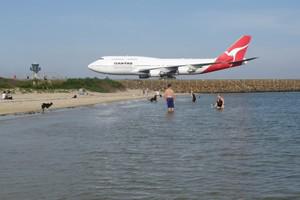Rising seasRising seas threaten Australia’s major airports – and it may be happening faster than we think
Most major airports in Australia are located on reclaimed swamps, sitting only a few meters above the present-day sea level. And the risk of sea level rise from climate change poses a greater threat to our airports than we’re prepared for. Given the significant disruption cost and deep uncertainty associated with the timing of sea level rise, we must adopt a risk-based approach which considers extreme sea level rise scenarios as part of coastal infrastructure planning.

Many Australian airports built near sea leel // Source: commons.wikimedia.org
Most major airports in Australia are located on reclaimed swamps, sitting only a few meters above the present-day sea level. And the risk of sea level rise from climate change poses a greater threat to our airports than we’re prepared for.
In fact, some of the top climate scientists now believe global sea-level rise of over two meters by 2100 is likely under our current trajectory of high carbon emissions.
This makes Cairns (less than 3m above sea level), Sydney and Brisbane (under 4m), and Townsville and Hobart (both around under 5m) airports among the most vulnerable.
In the US, the National Oceanic and Atmospheric Administration (NOAA) has recommended that global mean sea level rise of up to 2.7 meters this century should be considered in planning for coastal infrastructure.
This is two to three times greater than the upper limit of recommended sea level rise projections applied in Australia.
But generally, the amount of sea level rise we can expect over the coming century is deeply uncertain. This is because ice sheet retreat rates from global warming are unpredictable.
Given the significant disruption cost and deep uncertainty associated with the timing of sea level rise, we must adopt a risk-based approach which considers extreme sea level rise scenarios as part of coastal infrastructure planning.
Are we prepared?
As polar ocean waters warm, they can cause glaciers to melt from beneath, leading to more icebergs breaking off into the ocean and then a rapid rise in global sea level. This has happened multiple times in the Earth’s past and, on some occasions, in a matter of decades.
The Intergovernmental Panel on Climate Change (IPCC) puts sea level rise projections for Australia somewhere between 50 to 90 centimeters by 2090, relative to the average sea level measured between 1986 to 2005. But the emerging science indicates this may now be an underestimate.
